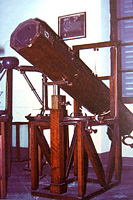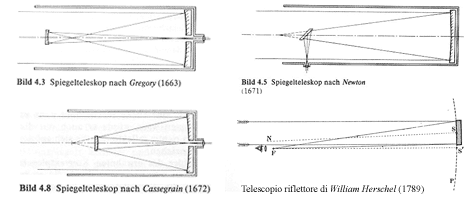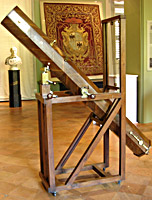Instruments
Reflecting Telescope
According to a note written by Amici himself and found among his papers, his interest in mirrors for telescopes began as early as 1809 when he would meet together with others interested in the mechanical arts in the Modena workshop of the gunsmith Mattioli. There Amici took part in metal composition experiments that Giuseppe Zoboli, “famous maker of achromatic telescopes” had the gunsmith carry out in an attempt to obtain a good alloy to be used in mirrors for telescopes.
Since I had some knowledge of theoretical optics, and since I remembered reading something about these matters in Smith and in Montucla’s History of Mathematics, I became involved and promised
to bring some alloys the next day which might be useful to this aim. Upon returning home where there was still a foundry and metalworker, Giuseppe Sgarbi, I had him fuse the two alloys which Montucla mentions (*), that is, the first composed of two parts copper, one tin and one brass, and the other of 32 parts copper, 15 tin, 1 silver, 1 brass and 1 arsenic. I thought they turned out well, especially the second alloy, and I took them to Mattioli’s workshop the next day. They were praised for their whiteness but were considered to be too friable to clean [...]
After having carried out many experiments, some of them invented by me, but to no great profit, I finally decided to try Smith’s method, which was to cover the plate with a piece of taffeta to which pitch dissolved in wine spirits is applied, and this is used over the piece to be cleaned along with calcined tin. But since I had no pitch I decided to use wax, melting it through the taffeta and I was delighted to have found an excellent way to clean the pieces [...]
The most difficult step to carry out was the curvature and I therefore dedicated all my attention to this matter.
(*) Jean Etienne Montucla, Histoire des Mathématiques, Nouvelle édition, considérablement augmentée, ecc., Tome troisième, Agasse, Paris, an X (1802), p. 501-502: “Les miroirs des télescopes sont
composés de 20 parties de cuivre rouge, 9 d’étain, et 8 d’arsénic blanc suivant Passement, Construction d’un telescope, 1738; où deux parties de cuivre, une de laiton, et une d’étain suivant Hadley: on les polit avec l’émeril et la potée d’étain, Smith, art. 796. On trouve dans le Nautical Almanac de 1787, une composition pour les miroirs, par Edwards, 32 parties de cuivre rouge, 15 d’étain, une de cuivre jaune, une d’argent et une d’arsénic. C’est de toutes les compositions celle qui est la plus blanche, la plus dure, et qui réfléchit le mieux la lumière. Elle procure à pareille ouverture, autant de lumière qu’il y en a dans les lunettes acromatiques, tandis que les télescopes ordinaires n’en ont pas le quart, Astr. 2431. Mais cette composition n’est pas bonne pour de très-grands miroirs, parce qu’elle est trop cassante”.
The first telescopes constructed by Amici which we know of are two reflectors he sent to Milan in April 1811: one for the small, private observatory of the Senator Pietro Moscati, and the other a gift to the Brera Observatory. Both these instruments had a diameter of 6 ½ inches (approximately 17.5 cm) and an objective mirror with a 7 and 2/3 Paris feet (about 250 cm) focus.
 The optical trials gave such very good results that the astronomers Oriani, Cesaris and Carlini proposed the telescope for an award and asked the government to commission a larger telescope to Amici. The Science Institute of Milan accepted this proposal and awarded Amici’s telescope with a gold medal on 15 August, 1811, in occasion of the National Exposition, judging it to be “equal to the Herschelian” telescope already in use at the Brera Observatory.
The optical trials gave such very good results that the astronomers Oriani, Cesaris and Carlini proposed the telescope for an award and asked the government to commission a larger telescope to Amici. The Science Institute of Milan accepted this proposal and awarded Amici’s telescope with a gold medal on 15 August, 1811, in occasion of the National Exposition, judging it to be “equal to the Herschelian” telescope already in use at the Brera Observatory.
In November of the same year the new reflector was ready. It had a focal length of 17 Paris feet and an aperture of 11 inches. It was the largest in Italy at that time, but its very dimension hampered its use. After the government expressed its favour in a report dated 23 November 1811, the astronomers of the Brera requested financing to provide the telescope with adequate support and an appropriate location. Many vicissitudes, including the fall of the Reign of Italy and the return of the Austrians, the excessive cost of the support and the necessity of constructing a new dome in which such a large instrument could be fixed, meant that as late as forty years after, in 1851, even though in the meantime it had been shortened in focus to 12 feet, this telescope still could not be used at its best. In fact, Carlini used it to look for comets (cf. Agnese Mandrino - Guido Tagliaferri - Pasquale Tucci, Gli strumenti astronomici di Amici a Milano, “Giornale di Fisica”, 2/3-1988; Idem, Amici’s Telescopes for Brera Observatory, “Nuncius”, 2-1989; A. Meschiari, Corrispondenza di Giovanni Battista Amici con Francesco Carlini, published by the Institute of General Applied Physics at the University of Milan, 2001).
Amici wrote in a note on 29 November 1814:
I presented the government with a telescope of 17 feet of length, now at the Brera, and I constructed another invented by myself, which received the gold medal from the Institute. [...]
I finally managed in the parabolic figure and so was able to make an eight foot telescope sustain a twelve inch aperture, thus obtaining the same effect that one has from a spherical telescope of 17 feet in length. Lately I have applied to it a new micrometer which exactly measures an angle of 4/60ths of a second, and which can easily be increased to the precision of only 1/60th of a second.
Thanks to this early success, many reflectors came out of Amici’s Modena workshop from 1812 to 1813, including one Newtonian telescope commissioned by Federigo Zuccari (1784-1817) for the new observatory being built at Capodimonte, Naples, with 18 cm of aperture and 270 cm (8 feet) focus (cf. Romano Gatto, Il cannocchiale Amici dell’Osservatorio astronomico di Capodimonte e la corrispondenza Amici-Zuccari, “Nuncius”, 2-1996); one for the observatory in Bologna with a focal length of 8 feet and a main mirror with 6 inch aperture (values supplied by the astronomer Ciccolini); a reflector with 6 ½ inch aperture and 7 2/3 feet focus for the Padua Astronomic Observatory; a concave mirror with 8 feet focus and 11 inch aperture for his own use to be mounted on a Newtonian telescope, to which Amici fixed his bisected lens micrometer to measure the diameter of planets and the distance of the double stars (cf. Edoardo Proverbio - Pasquale Tucci, Giovan Battista Amici costruttore di telescopi e cannocchiali acromatici, “Physis”, 1-1993).
 The report which Lodovico Ciccolini sent the Regent Professor of the University of Bologna on 14 April 1813 said, about the telescope:
The report which Lodovico Ciccolini sent the Regent Professor of the University of Bologna on 14 April 1813 said, about the telescope:
“The telescope constructed by Prof. G.B. Amici as ordered by the government for use in this observatory was delivered by him to me on 3 April. It is 8 feet in length and has an aperture of 6 inches, is supplied with 6 eyepieces and it is fixed onto a base which permits the necessary vertical and horizontal movement using two handles”.
In the period around 1817 the following reflecting telescopes were constructed in Amici’s workshop:
- Gregorian telescope of 22 inches with tube and base in brass, free movement, price Italian £ 360
- Another of the same length, horizontal movement, and vertical with an endless screw, supplied with two eyepieces or two small mirrors, with a case in walnut, £520
- Same construction, 30 inches long, with four different magnifications, £800
- Another of 36 inches, £1000
- Another of 60 inches, £2000
- Another of 80 inches, £3000
- The Cassegrain telescopes with the focal length of the preceding ones have the same respective prices
- Newtonian telescope with a two foot focus and three inch aperture, tube and support in wood, two eyepieces, £350
- Similar with a four foot focus and five inch aperture, four eyepieces, £1000
- Ditto, with eight foot focus and 6 ½ inch aperture, five eyepieces, £1300
- Newtonian telescope with eight foot focus and eleven inch aperture, five eyepieces with lateral, external, reflecting micrometer, invented by the author and never mentioned in publications £4500
- Ditto, with bisected lens micrometer, equipped for the determination of the diameters of the sun and of the moon, illumination of the wires along the axis of the tube, achromatic finder, 5 common eyepieces and two achromatic, £6000
- Zodiacal telescope with three foot focus and three inch aperture, fixed tube, £1000
- Ditto, with eight foot focus and six inch aperture, £3000
(the last three created by the Author)

[The optical drawings of the Gregory, Cassegrain and Newtontelescopes come from Rolf Riekher, Fernrohre und ihre Meister, 2., stark bearbeitete Auflage, Verlag Technik, Berlin 1990. The optical drawing of the Herschelian telescope is from A. Danjon - A. Couder, Lunettes et telescopes, Paris 1935].
On 10 July 1824, Joseph Fraunhofer (1787-1826) showed the scientific world his large refractor for Dorpat. This fact seemed to many the sign that reflector were a thing of the past and of insuperable inferiority. John Frederik William Herschel, in a letter from Slough dated 15 August 1825 to the editor of the “Astronomische Nachrichten”, took a clear position in the reflector-refractor dispute: “Those who have witnessed the performance of M. Amici’s beautiful Newtonian reflectors, will not readily admit this inferiority” (Schreiben des Herrn J. F. W. Herschel F. R. S. an den Herausgeber. Slough 1825, Aug. 15, “Astronomische Nachrichten”, IV-1826; cf. also Guglielmo Righini, Storia e vicende degli obbiettivi astronomici di G. B. Amici, “Physis”, XI-1969).
In August of 1827 the new Modena Observatory created in the East Tower of the Ducal Palace was born. Amici had provided the transit instrument, an equatorial telescope and a Newtonian telescope of 8 focal feet and 6 inches of aperture for it, the latter consigned to the astronomer Giuseppe Bianchi in June 1820. This telescope, pictured here, was described by Bianchi in an inventory of the observatory dated 31 May 1845:
This large catadioptric telescope, the first to be purchased by the Observatory and produced by Prof. Amici, has the larger mirror with a 6 inch aperture and about an 8 foot focus, it has three night eyepieces with [empty space] magnifications, and one day eyepiece, and it is screwed in a tube of wood with a transversal octagonal form, externally veneered, mobile with small and large movements and mounted on a wheeled cart.
Further information about this instrument can be found in a note dated January 1833 concerning the observation of the disappearance and reappearance of Saturn’s ring. The assistant astronomer, Bianchi wrote,
observed with Amici’s telescope with the focal length of 7 feet 9 inches, an aperture of 75 lines and the stronger magnification of 371. I used the same telescope during the reappearance of the ring, but with the magnification of 279, which is better for clearness and distinctness of outline.

